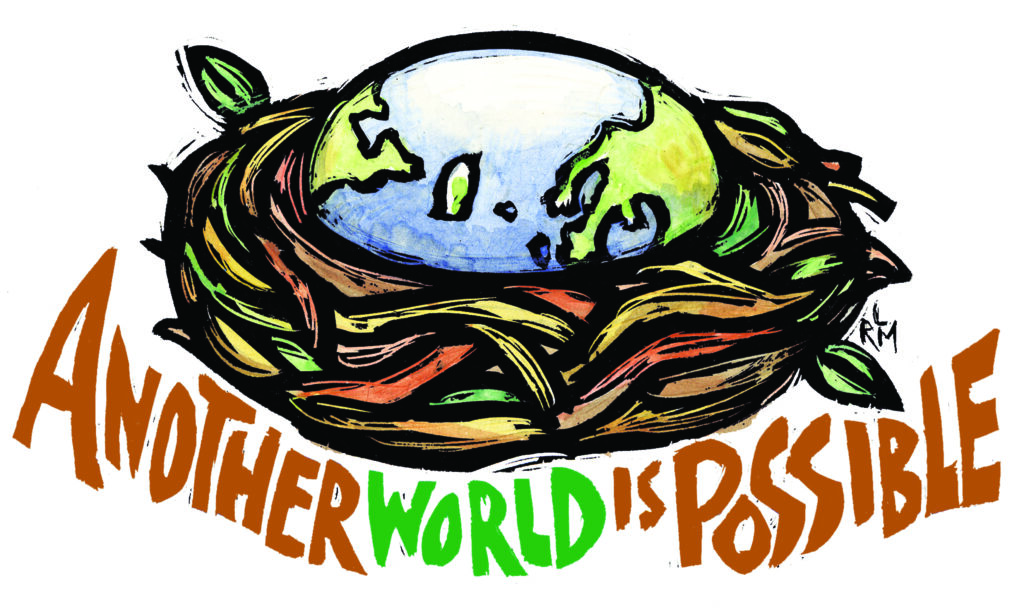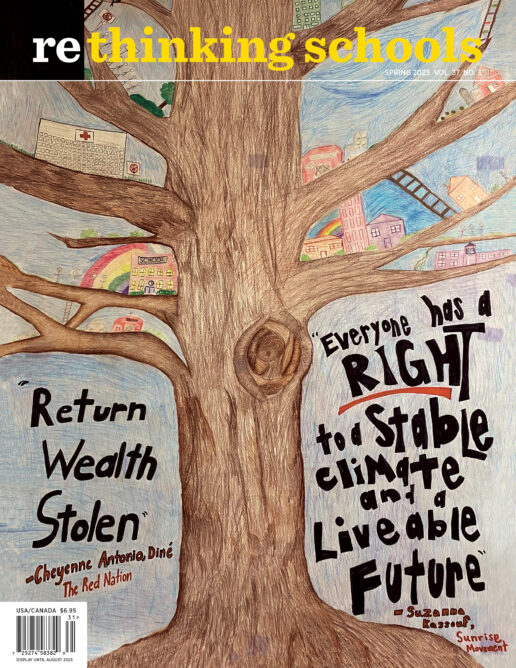Our Classrooms, Our Future

In his compelling new novel The Deluge, author Stephen Markley paints a grim portrait of the future: overlapping and escalating climate disasters, economic chaos, growing inequality, state violence, hyper surveillance, religious fanaticism — and capitalists seeking to profit from each and every calamity. Frankly, it is a plausible future.
But.
This is not a portrait of the future that will motivate our students to create something different, something better. Whether interlocking ecological and social catastrophes becomes our actual future depends in part on our students’ capacity to understand the present and imagine something different.
In the introduction to our book Rethinking Our Classrooms, first published almost 30 years ago, editors wrote that “Classroom life should, to the greatest extent possible, prefigure the kind of democratic and just society we envision and thus contribute to building that society.”
All curriculum — how we organize our classrooms, how we treat our students, the content of our lessons — embeds a vision of the future. This insight weaves through articles in this issue of Rethinking Schools.
In Ayva Thomas’s interview with Chris Emdin, Emdin emphasizes the importance of what the classroom and school environment itself teaches students:
I’m aware that classrooms with bars and windows incarcerate the minds of young people. I’m aware that metal detectors make young people feel as though they are criminals. I’m aware of what a dirty environment does to young people’s feelings of worth.
When you throw students in that kind of school, that kind of classroom, and then say I love you, the students feel that tension — That love can’t be real.
Emdin tells Thomas that we need to design classrooms as “spaces that center the voices and the aesthetic representations of marginalized folks and that allow them to see the beauty in themselves.” Students will more easily imagine a beautiful, diverse, and just future if they are surrounded by a beautiful, diverse, and just present.
In “‘No More Elegies Today’ — Building a Classroom Habit of Joy,” Rethinking Schools editor Linda Christensen frames her work with students:
Yes, we must acknowledge and teach about what’s happening in the world, but we also need to help students find and celebrate what they love about their lives. We live in a world filled with war, white supremacy, the climate crisis, a growing unhoused population, gun violence, attacks on women’s and LGBTQ+ rights, and more. Our path to survival must also include memories of all that is good and right: shared belly laughs with siblings and friends, the glory of waves at the ocean, the thrill of catching our first fish, the big hug of a friend who brought us a broom to sweep out the old year.
Christensen teaches Clint Smith’s poem “No More Elegies Today.” The classroom she describes — in which “students can be seen and heard, where they can share their joys, but also their pain and sorrow, and find comfort and new ways of seeing each other” — prefigures aspects of the world we want to live in, and thus nurtures students’ commitment to create that world.
Climate Change
Of course, we cannot think about the future without acknowledging the climate emergency. In this issue, physics teacher Elissa Levy describes how being equipped with knowledge about the physics of climate change can arm students to combat climate disinformation, intended to prolong the era of fossil fuels, “perpetuated by people with extreme power whose near-term profits shrink when we address the climate crisis.”
Two more climate-related articles explicitly engage students’ imaginations about what may lie ahead: Suzanna Kassouf’s “‘We Cannot Create What We Cannot Imagine’: Helping Students Picture Climate Justice,” and Eric Fishman’s “Imagining Climate Futures: Fifth and Sixth Graders Write Place-Based Speculative Fiction.”
Fishman’s students imagine themselves in 2050 — but not generically. He asks them to imagine themselves in a specific place, one with personal meaning. Inevitably, some of Fishman’s students construct bleak futures; the more one knows about the enormity of climate destabilization, the easier it is to imagine hard times ahead. But through writing and revision, Fishman also nudges students to think in terms of effective mitigation strategies and activist responses.
As Fishman sums up: “In writing speculative fiction about places they love, students can begin to imagine the concrete impacts of climate change on their lives — and how we can act to protect our communities and build a more just future.”
Suzanna Kassouf describes her 9th-grade inquiry class “imagining, conjuring, and rendering a future — not of apocalyptic wildfire smoke and mass death — but of solidarity, care, and possibility.” But Kassouf’s exercise is not a dreamy, “we are the world” brainstorm about an abstract utopia. She engages students in a role play with students taking on the personas of actual people — activists throughout the country who “work together to create a collective, robust vision of the future they are fighting for.”
Kassouf tells her students, “We’re going to spend the next few days imagining what the future could look like. Each of you is going to take part in that imagining. You will attend a visioning conference representing organizations working on housing, immigration, Indigenous rights, food and farming, youth activism, jobs, and racial justice.” Students’ final assignment is to create murals for display in schools throughout the country to articulate a concrete social vision that expresses the concerns of every individual in the role play.
Kassouf describes her aim:
I wanted these murals to allow students the visceral experience of imagining and building a different future. Students are bombarded daily with news of destruction: the destruction of the planet, the destruction of our democracy, the destruction of Black lives and bodies. To build something different, students’ need to experience the joy of creation. Creating is the magical antidote to the suffering of our world. By investigating the root of this suffering, we can dig it up and plant something new. Schools are the gardens of our societies, where we can nurture the radical imagination needed to picture a new world, and grow the skills required to build it.
The result? Kassouf explains:
On our last day of school, after a year of uncovering the pain of our world, our classroom was covered with images of what a different world could look like: one of solidarity, connection with the natural world, harmony between peoples and nations, and strong, thriving communities.
Every day, the world is unfolding a frightening dystopia for our students. Our schools and classrooms should be sites that argue for the possibility of something better. In every way we can think of, our schools should tell our students: Another world is possible.

